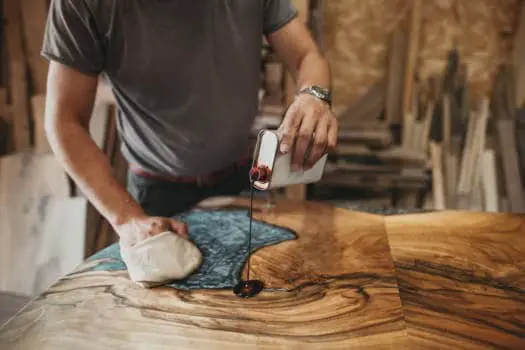
For me, finishing was one of the most difficult decisions when making my first couple projects. It’s this way because there are minimal search results, and a lot of YouTube videos don’t fully lay it out.
So what are my top 3 ways to finish an epoxy and wood table?
- Finish With a Thin Coat of Epoxy
- Sand and Seal With Oil (or Polyurethane Varnish)
- Sand and Polish
- Combine the Oil and Polish
Not only are these the most common and popular ways for people to finish the table, they are also going to make it look the best. Despite being straightforward, each comes with their advantages and drawbacks. I will explore these below and also go into more on picking which is right for you.
Finish With a Thin Coat of Epoxy
This will be one of the most seen methods. There are a couple scenarios where this works incredibly well, and produces the beautiful aesthetic that people really want. For this I like to use a table top epoxy resin.
The first place this works well is in bars and coffee shops. Think about it, any time you go to these types of places, you have the super high gloss, waterproof, shining tables. This works great for multiple reasons. First, it gives off a great look when the lights are low but tables shine, picture perfect. Second, it’s super practical. Bars and coffee shops are prone to spills. They see multiple spills per day. Because of this, they want something that is going to be durable and waterproof. A nice 1/8 to 1/4 inch pour will be perfect for what these venues are looking for.
The other big scenario is going to be plain, fully wooden tables. Usually tables with colored epoxy in them don’t use this method as much. This goes hand in hand with the last scenario as this is what bars and coffee shops often have in them. In a sense, it detracts from the beauty of the colored epoxy to have everything just as shiny and durable. For this reason, you see it on the fully-wooden tables where it won’t detract from the rest of it.
It is also common on small live edge pieces like home coffee tables. This makes sense, they serve the same purpose as coffee shop tables and bars in that they are there primarily for drink-holding. It doesn’t detract from this, even live edge, because the whole thing is one solid type of wood it helps the natural beauty stand out.
Sand and Seal With Oil (or Polyurethane Varnish)
The second method is to sand down everything, and use an oil or varnish. Common oils are going to be plant-based or mineral oils. This creates the least glossy of the three options, and is used a lot for things like cutting boards and serving trays because it is easy to find oils that are food safe. Although those aren’t tables, they are super common projects in woodworking (especially with epoxy) and this is still a viable option.
You might also like this option when it comes to a desk, or children’s furniture. It is less likely to cost a lot, and it does seem to work practical for those types of projects.
Sand and Polish
This is a great option for those working with epoxy and wood on a table. If you are doing the incredibly popular river tables, this is probably the most popular and practical option for you.
This method of sanding and then polishing, usually with a wax of some sort, is going to give you the “in-between” of glossy and matte. This is great because it will really emphasize both the wood, and the epoxy. It will be great for an increased durability over just the oil, but won’t be as glossy as the epoxy coat.
Combine the Oil and Polish
The last two steps can be combined in order to make an even more unique finish. Although it isn’t necessary, adding the oils can make the wood have a lot more pop to it’s natural beauty, thus increasing the noticeability of the wood while it sits next to epoxy. This is going to create a very classic – yet still modern – table that will leave everyone impressed.
Each method has it’s merits and should be used in a variety of situations. In my own opinion, finishing with this last option is the best way to go for wood and epoxy tables.
How to Pick the Method You Use?
This is going to be up to you as the creator! Decide what you like, and go with it. I can offer some suggestions as to what I think looks best, but in the end each piece will be unique and show its beauty!
For the Thin Epoxy Coat
- Bar Tables
- Coffee Tables
- Fully Wooden Pieces (depending on the look you want)
- Anything With High Traffic
For the Oil Only
- Cutting Boards
- Serving Trays
- Butcher Blocks
- Children’s Furniture
For Polish or Oil and Polish
- Dining Tables
- Desks
- Large Furniture
These are obviously just my suggestions and personal preferences. Utilize your creative abilities to make the best possible option for you! There are limitless ways to make epoxy resin tables as each piece is completely unique. Leave a comment and let me know what your personal preference is and why! I love to try my readers suggestions out.


